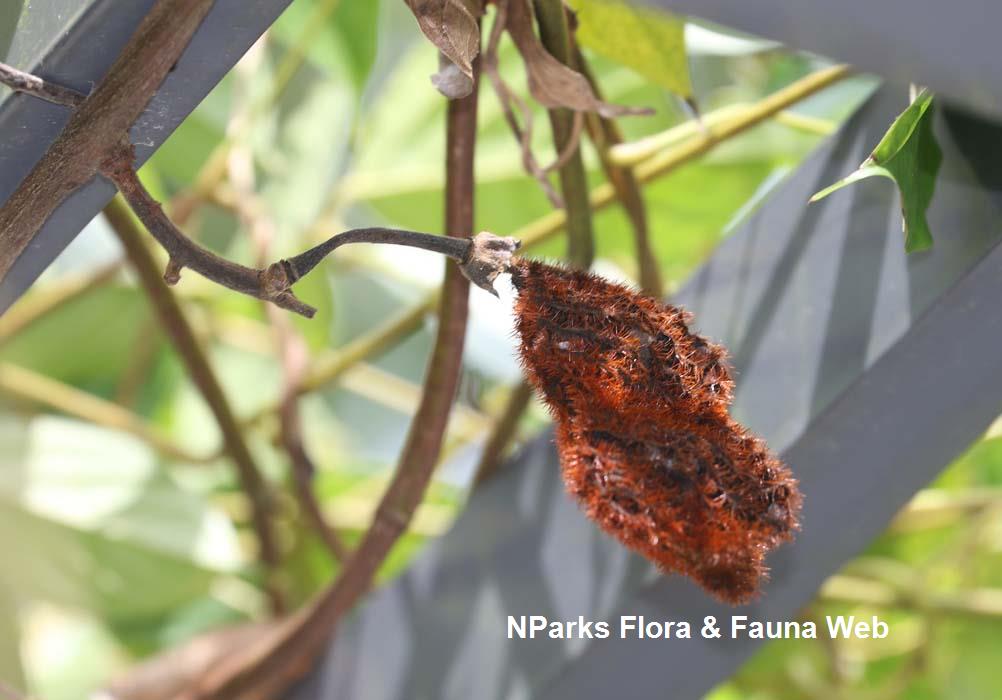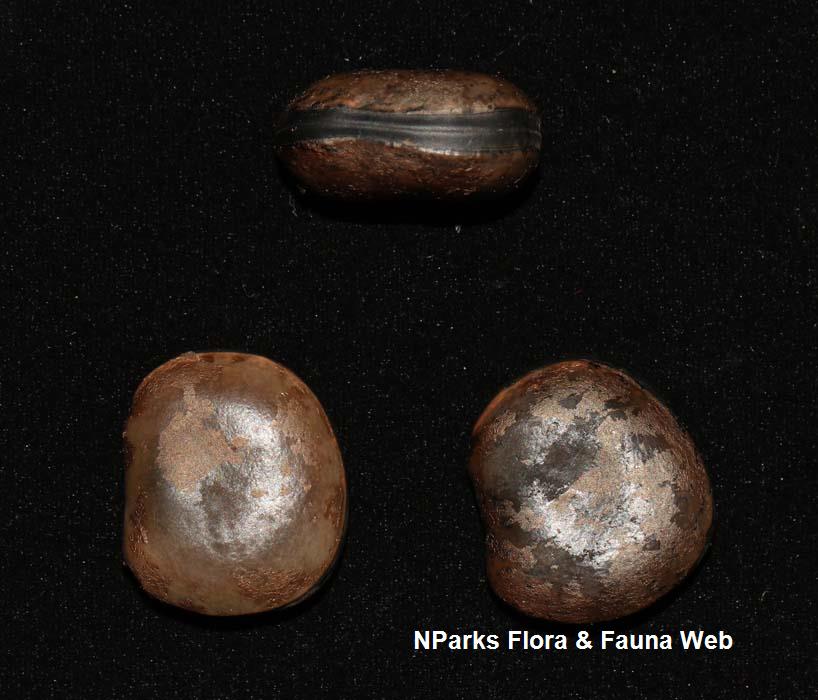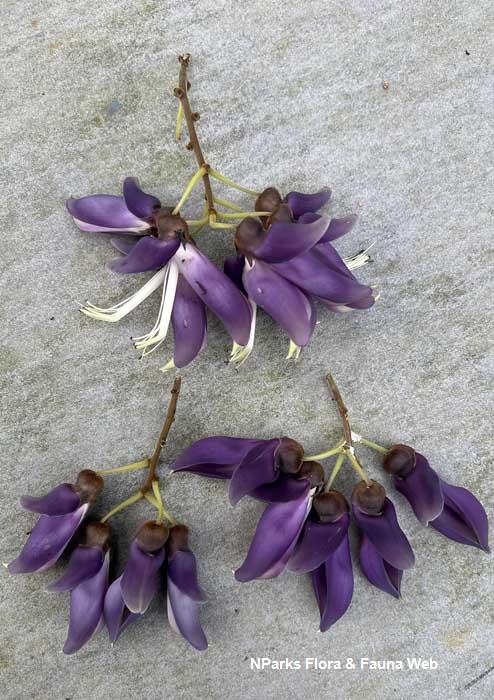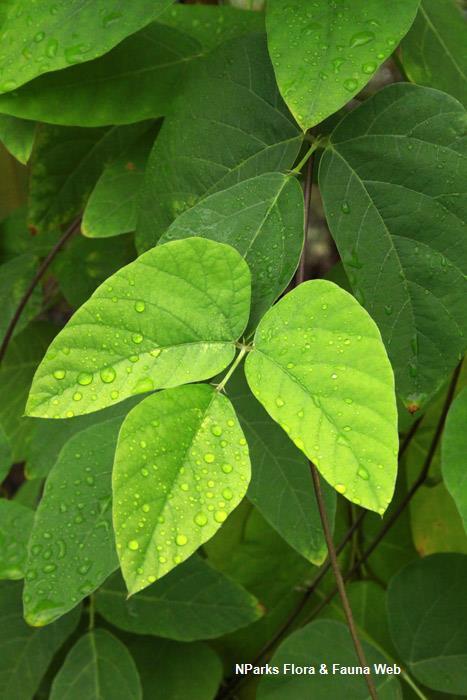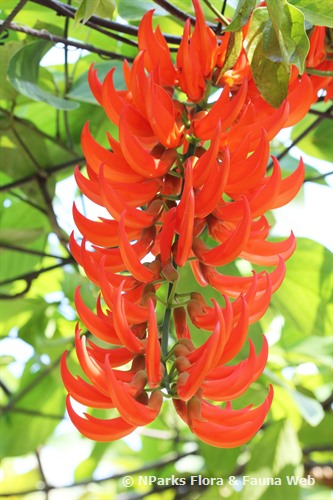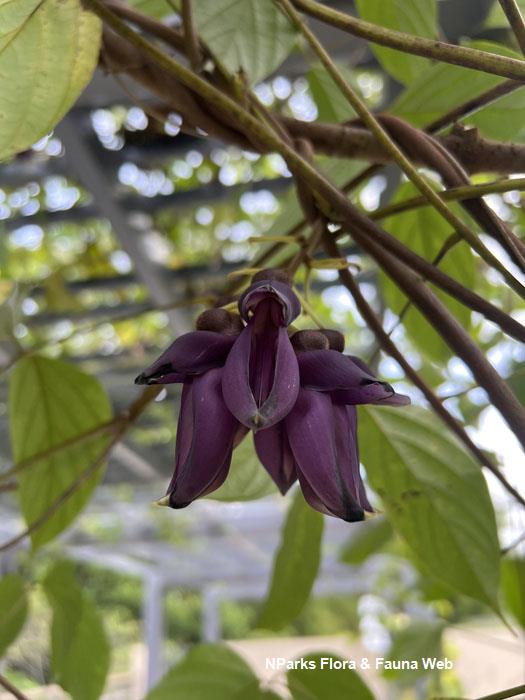
Back
Mucuna biplicata Teijsm. & Binn. ex Kurz
| Family Name: | Fabaceae (Leguminosae) |
| Common Name: | Two-fold Velvet Bean |
Two-fold Velvet Bean (Mucuna biplicata) is a woody vine with twining stems. It produces winged seed pods with red bristles and and dark purple flowers.
Name
Classifications and Characteristics
| Plant Division | Angiosperms (Flowering Seed Plants) (Dicotyledon) |
|---|---|
| Plant Growth Form | Climber |
| Lifespan (in Singapore) | Perennial |
| Mode of Nutrition | Autotrophic |
Biogeography
| Native Distribution | Borneo, Cambodia, Malaya, Singapore, Sumatra. |
|---|---|
| Native Habitat | Terrestrial |
| Preferred Climate Zone | Tropical |
| Local Conservation Status | Native to Singapore (Critically Endangered (CR)) |
Description and Ethnobotany
| Growth Form | Woody vine |
|---|---|
| Foliage | Leaves are alternately arranged along the stem. Leaf is pinnately trifoliolate with long leaflet tips, glabrous on the upper surface and very sparsely hairy below; terminal leaflet broadly elliptic with rounded base, while the lateral leaflets asymmetrical. Stipules are lanceolate and hairy about 1.5 mm long and early caducous (fall off early). Petioles are 6 - 11 cm long, smooth to sparsely pubescent (fine short hairs) at the pulvinus. |
| Stems | Glabrous stem (smooth stem) |
| Flowers | Inflorescences are axillary on leafless branches, pendulous, measuring 4.,5 - 7 cm long with 5-6 short branches. Bracts and bracteole fall off very early (not seen, only scars are observed). Calyx is campanulate, cup-shaped of 10 mm long and 4 cm across when in buds. Each flower has 4 calyx lobes, dark purple corolla, about 2.5 x 2.2 cm. |
| Fruit | Fruit pod, leathery, oblong with rounded apex and base, measuring 5-7.5 cm long and 3-3.5 cm wide, about 1.5cm thick. Fruit pod is flattened, winged and not swollen around the seeds. Mature pod has abundant reddish-brown irritant bristles. |
| Habitat | In Singapore, it is found along the canal banks that was formerly a natural river. The species is likely to be dispersed by running water judging from its affinity with streams and riverbanks. |
| Etymology | The specific epithet "biplicata" is Latin which means two and folded lengthwise, referring to the bifurcating pod lamellae. |
Landscaping Features
| Landscaping | This climbing vine has ornamental deep purple flowers and red fruit pods, and can be trained on trellises. |
|---|---|
| Desirable Plant Features | Ornamental Flowers, Ornamental Fruits |
| Landscape Uses | Trellis / Arbour / Pergola |
| Usage Hazard - Cons | Irritant - Hairs |
Fauna, Pollination and Dispersal
| Seed or Spore Dispersal | Abiotic (Water) |
|---|
Plant Care and Propagation
| Light Preference | Full Sun |
|---|---|
| Water Preference | Moderate Water |
| Plant Growth Rate | Fast to Moderate |
| Rootzone Tolerance | Moist Soils |
| Propagation Method | Seed, Stem Cutting |
Foliar
| Foliage Retention | Evergreen |
|---|---|
| Mature Foliage Colour(s) | Green |
| Mature Foliage Texture(s) | Smooth |
| Prominent Young Flush Colour(s) | Green |
| Young Flush Texture(s) | Smooth |
| Foliar Type | Compound (Trifoliate) |
| Foliar Arrangement Along Stem | Alternate |
| Foliar Attachment to Stem | Petiolate |
| Foliar Shape(s) | Non-Palm Foliage (Lanceolate) |
| Foliar Venation | Pinnate / Net |
| Foliar Margin | Entire - Wavy / Undulate |
| Foliar Apex - Tip | Caudate |
| Foliar Base | Rounded / Obtuse |
Non - Foliar and Storage
| Stem Type & Modification | Woody |
|---|---|
| Root Type | Underground |
Floral (Angiosperm)
| Flower Colour(s) | Purple |
|---|---|
| Flower Texture(s) | Velvety / Furry / Tomentose |
| Flower Grouping | Cluster / Inflorescence |
| Flower Location | Axillary |
| Flower Symmetry | Bilateral |
| Individual Flower Shape | Papilionaceous / Pea-shaped |
References
| References | Ho, B.C. & Lua, H.K. (2022). Flora of Singapore precursors, 32: Discoveries in Mucuna (Leguminosae, subfamily Papilionoideae) with a review of the genus in Singapore. Gardens' Bulletin Singapore 74(1): 37-55. |
|---|
Image Repository
Others
| Master ID | 30706 |
|---|---|
| Species ID | 5018 |
| Flora Disclaimer | The information in this website has been compiled from reliable sources, such as reference works on medicinal plants. It is not a substitute for medical advice or treatment and NParks does not purport to provide any medical advice. Readers should always consult his/her physician before using or consuming a plant for medicinal purposes. |

